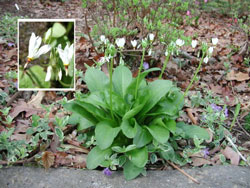Resource Library
Plant of the Week: Star, Shooting
The University of Arkansas System Division of Agriculture does not promote, support or recommend plants featured in "Plant of the Week." Please consult your local Extension office for plants suitable for your region.
Plant of the Week
Shooting Star
Latin: Dodecatheon meadia

Wildflowers can be appreciated on many levels. Some people stop at knowing only their ornamental features - their showy flowers or leafy greenness - but this knowledge is superficial and incomplete. Pretty spring wildflowers such as shooting star (Dodecatheon sp.) have a much more interesting backstory than their delicate beauty signifies.
Seventeen species of shooting stars, including one that jumped the Bering Strait to establish itself in Siberia, are native to North America. All are herbaceous perennials with leaves produced in rosettes at the ground level and flowers held on multiple-flowered peduncles well above the foliage in mid-to-late spring.
The most commonly met is D. meadia, a white, or occasionally pink- or purple-flowered species, native in the upland parts of the eastern deciduous forest. It grows about 16 inches in height with each inflorescence containing from eight to 20 blooms. The inch-long, shuttlecock-shaped bloom is distinctive, with five backward swept petals prominently displaying the reproductive parts of the flower.
Though the white-flowered shooting star is the species’ most common, gardeners recognize it is an outlier amongst the other species. Most shooting stars have pinkish or purplish blooms and are found in the high mountains of the West. In the past few years, scientists have focused a lot of attention on this group and have attempted to tease out of it the why’s and how’s of its evolutionary history.
Botanists have long recognized that shooting stars are closely related to primroses, a genus of almost 500 species that occurs mainly in Europe and Asia. However, North America does have about 20 species of primroses in the mountains of the West. These primroses share two telling features with shooting stars - they have flowers of about the same colors and hues, and both groups have a base number of 22 chromosomes. Interestingly, Eurasian primroses have 11 chromosomes.
DNA analysis shows shooting stars to have 100 percent relatedness with American primroses using "bootstrap frequency analysis," a statistical procedure for judging kinship. Evolutionary biologists believe a now-extinct ancestral form of primrose lost a specific pollinator and shooting stars were forced to adopt a new pollination system called "buzz-pollination." In this case, bees saved the day, maintaining a system of forced cross-pollination and quickly fixing the backswept petals of the shooting stars.
Carried to its logical conclusion, all this research has led some botanists to suggest - what else? - name changes. They would like to rename the shooting stars, making them all primroses. Fortunately this radical idea hasn’t caught on, and it was not adopted by the new Flora of North America. So for now, gardeners are saved from having to make new nametags for their plants.
Shooting stars have the same cultural requirements as primroses - namely, they want a highly organic, uniformly moist soil and relatively cool temperatures. Though shooting stars will grow in full sun, they only do so when the soil is kept moist during the summer. They are easier to grow in warm climates, sequestered in shaded woodland gardens where the soil never gets completely dry during the summer. They can be grown from seed, but getting plants through the seedling phase requires close attention to cultural needs. But once established in the garden, shooting star is a long-lived perennial.
By: Gerald Klingaman, retired
Extension Horticulturist - Ornamentals
Extension News - April 17, 2009
The University of Arkansas System Division of Agriculture does not maintain lists of retail outlets where these plants can be purchased. Please check your local nursery or other retail outlets to ask about the availability of these plants for your growing area.